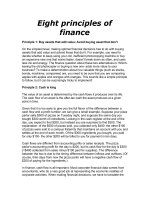Tài liệu PDF Ecology of Fungi
Bạn đang xem bản rút gọn của tài liệu. Xem và tải ngay bản đầy đủ của tài liệu tại đây (2.18 MB, 9 trang )
Ecology of Fungi
Ecology of Fungi
Bởi:
OpenStaxCollege
Fungi play a crucial role in the balance of ecosystems. They colonize most habitats
on Earth, preferring dark, moist conditions. They can thrive in seemingly hostile
environments, such as the tundra, thanks to a most successful symbiosis with
photosynthetic organisms like algae to produce lichens. Fungi are not obvious in the way
large animals or tall trees appear. Yet, like bacteria, they are the major decomposers of
nature. With their versatile metabolism, fungi break down organic matter, which would
not otherwise be recycled.
Habitats
Although fungi are primarily associated with humid and cool environments that provide
a supply of organic matter, they colonize a surprising diversity of habitats, from
seawater to human skin and mucous membranes. Chytrids are found primarily in aquatic
environments. Other fungi, such as Coccidioides immitis, which causes pneumonia
when its spores are inhaled, thrive in the dry and sandy soil of the southwestern United
States. Fungi that parasitize coral reefs live in the ocean. However, most members of
the Kingdom Fungi grow on the forest floor, where the dark and damp environment is
rich in decaying debris from plants and animals. In these environments, fungi play a
major role as decomposers and recyclers, making it possible for members of the other
kingdoms to be supplied with nutrients and live.
Decomposers and Recyclers
The food web would be incomplete without organisms that decompose organic matter
([link]). Some elements—such as nitrogen and phosphorus—are required in large
quantities by biological systems, and yet are not abundant in the environment. The
action of fungi releases these elements from decaying matter, making them available
to other living organisms. Trace elements present in low amounts in many habitats are
essential for growth, and would remain tied up in rotting organic matter if fungi and
bacteria did not return them to the environment via their metabolic activity.
1/9
Ecology of Fungi
Fungi are an important part of ecosystem nutrient cycles. These bracket fungi growing on the
side of a tree are the fruiting structures of a basidiomycete. They receive their nutrients through
their hyphae, which invade and decay the tree trunk. (credit: Cory Zanker)
The ability of fungi to degrade many large and insoluble molecules is due to their
mode of nutrition. As seen earlier, digestion precedes ingestion. Fungi produce a variety
of exoenzymes to digest nutrients. The enzymes are either released into the substrate
or remain bound to the outside of the fungal cell wall. Large molecules are broken
down into small molecules, which are transported into the cell by a system of protein
carriers embedded in the cell membrane. Because the movement of small molecules and
enzymes is dependent on the presence of water, active growth depends on a relatively
high percentage of moisture in the environment.
As saprobes, fungi help maintain a sustainable ecosystem for the animals and plants that
share the same habitat. In addition to replenishing the environment with nutrients, fungi
interact directly with other organisms in beneficial, and sometimes damaging, ways
([link]).
Shelf fungi, so called because they grow on trees in a stack, attack and digest the trunk or
branches of a tree. While some shelf fungi are found only on dead trees, others can parasitize
2/9
Ecology of Fungi
living trees and cause eventual death, so they are considered serious tree pathogens. (credit:
Cory Zanker)
Mutualistic Relationships
Symbiosis is the ecological interaction between two organisms that live together. The
definition does not describe the quality of the interaction. When both members of
the association benefit, the symbiotic relationship is called mutualistic. Fungi form
mutualistic associations with many types of organisms, including cyanobacteria, algae,
plants, and animals.
Fungus/Plant Mutualism
One of the most remarkable associations between fungi and plants is the establishment
of mycorrhizae. Mycorrhiza, which comes from the Greek words myco meaning fungus
and rhizo meaning root, refers to the association between vascular plant roots and
their symbiotic fungi. Somewhere between 80 and 90 percent of all plant species
have mycorrhizal partners. In a mycorrhizal association, the fungal mycelia use their
extensive network of hyphae and large surface area in contact with the soil to channel
water and minerals from the soil into the plant. In exchange, the plant supplies the
products of photosynthesis to fuel the metabolism of the fungus.
There are a number of types of mycorrhizae. Ectomycorrhizae (“outside” mycorrhiza)
depend on fungi enveloping the roots in a sheath (called a mantle) and a Hartig
net of hyphae that extends into the roots between cells ([link]). The fungal partner
can belong to the Ascomycota, Basidiomycota or Zygomycota. In a second type, the
Glomeromycete fungi form vesicular–arbuscular interactions with arbuscular
mycorrhiza (sometimes called endomycorrhizae). In these mycorrhiza, the fungi form
arbuscules that penetrate root cells and are the site of the metabolic exchanges between
the fungus and the host plant ([link] and [link]). The arbuscules (from the Latin for
little trees) have a shrub-like appearance. Orchids rely on a third type of mycorrhiza.
Orchids are epiphytes that form small seeds without much storage to sustain germination
and growth. Their seeds will not germinate without a mycorrhizal partner (usually a
Basidiomycete). After nutrients in the seed are depleted, fungal symbionts support the
growth of the orchid by providing necessary carbohydrates and minerals. Some orchids
continue to be mycorrhizal throughout their lifecycle.
Art Connection
3/9
Ecology of Fungi
(a) Ectomycorrhiza and (b) arbuscular mycorrhiza have different mechanisms for interacting
with the roots of plants. (credit b: MS Turmel, University of Manitoba, Plant Science
Department)
If symbiotic fungi are absent from the soil, what impact do you think this would have on
plant growth?
The (a) infection of Pinus radiata (Monterey pine) roots by the hyphae of Amanita muscaria (fly
amanita) causes the pine tree to produce many small, branched rootlets. The Amanita hyphae
cover these small roots with a white mantle. (b) Spores (round bodies) and hyphae (thread-like
structures) are evident in this light micrograph of an arbuscular mycorrhiza between a fungus
and the root of a corn plant. (credit a: modification of work by Randy Molina, USDA; credit b:
modification of work by Sara Wright, USDA-ARS; scale-bar data from Matt Russell)
Other examples of fungus–plant mutualism include the endophytes: fungi that live
inside tissue without damaging the host plant. Endophytes release toxins that repel
herbivores, or confer resistance to environmental stress factors, such as infection by
microorganisms, drought, or heavy metals in soil.
Evolution Connection
4/9
Ecology of Fungi
Coevolution of Land Plants and MycorrhizaeMycorrhizae are the mutually beneficial
symbiotic association between roots of vascular plants and fungi. A well-accepted
theory proposes that fungi were instrumental in the evolution of the root system in plants
and contributed to the success of Angiosperms. The bryophytes (mosses and liverworts),
which are considered the most primitive plants and the first to survive on dry land,
do not have a true root system; some have vesicular–arbuscular mycorrhizae and some
do not. They depend on a simple rhizoid (an underground organ) and cannot survive
in dry areas. True roots appeared in vascular plants. Vascular plants that developed a
system of thin extensions from the rhizoids (found in mosses) are thought to have had
a selective advantage because they had a greater surface area of contact with the fungal
partners than the mosses and liverworts, thus availing themselves of more nutrients in
the ground.
Fossil records indicate that fungi preceded plants on dry land. The first association
between fungi and photosynthetic organisms on land involved moss-like plants and
endophytes. These early associations developed before roots appeared in plants. Slowly,
the benefits of the endophyte and rhizoid interactions for both partners led to presentday mycorrhizae; up to about 90 percent of today’s vascular plants have associations
with fungi in their rhizosphere. The fungi involved in mycorrhizae display many
characteristics of primitive fungi; they produce simple spores, show little diversification,
do not have a sexual reproductive cycle, and cannot live outside of a mycorrhizal
association. The plants benefited from the association because mycorrhizae allowed
them to move into new habitats because of increased uptake of nutrients, and this gave
them a selective advantage over plants that did not establish symbiotic relationships.
Lichens
Lichens display a range of colors and textures ([link]) and can survive in the most
unusual and hostile habitats. They cover rocks, gravestones, tree bark, and the ground in
the tundra where plant roots cannot penetrate. Lichens can survive extended periods of
drought, when they become completely desiccated, and then rapidly become active once
water is available again.
Link to Learning
Explore the world of lichens using this site from Oregon State University.
5/9
Ecology of Fungi
Lichens have
many forms. They may be (a) crust-like, (b) hair-like, or (c) leaf-like. (credit a:
modification of work by Jo Naylor; credit b: modification of work by
"djpmapleferryman"/Flickr; credit c: modification of work by Cory Zanker)
Lichens are not a single organism, but rather an example of a mutualism, in which
a fungus (usually a member of the Ascomycota or Basidiomycota phyla) lives in
close contact with a photosynthetic organism (a eukaryotic alga or a prokaryotic
cyanobacterium) ([link]). Generally, neither the fungus nor the photosynthetic organism
can survive alone outside of the symbiotic relationship. The body of a lichen, referred
to as a thallus, is formed of hyphae wrapped around the photosynthetic partner. The
photosynthetic organism provides carbon and energy in the form of carbohydrates.
Some cyanobacteria fix nitrogen from the atmosphere, contributing nitrogenous
compounds to the association. In return, the fungus supplies minerals and protection
from dryness and excessive light by encasing the algae in its mycelium. The fungus also
attaches the symbiotic organism to the substrate.
This cross-section of a lichen thallus shows the (a) upper cortex of fungal hyphae, which
provides protection; the (b) algal zone where photosynthesis occurs, the (c) medulla of fungal
6/9
Ecology of Fungi
hyphae, and the (d) lower cortex, which also provides protection and may have (e) rhizines to
anchor the thallus to the substrate.
The thallus of lichens grows very slowly, expanding its diameter a few millimeters per
year. Both the fungus and the alga participate in the formation of dispersal units for
reproduction. Lichens produce soredia, clusters of algal cells surrounded by mycelia.
Soredia are dispersed by wind and water and form new lichens.
Lichens are extremely sensitive to air pollution, especially to abnormal levels of
nitrogen and sulfur. The U.S. Forest Service and National Park Service can monitor
air quality by measuring the relative abundance and health of the lichen population in
an area. Lichens fulfill many ecological roles. Caribou and reindeer eat lichens, and
they provide cover for small invertebrates that hide in the mycelium. In the production
of textiles, weavers used lichens to dye wool for many centuries until the advent of
synthetic dyes.
Link to Learning
Lichens are used to monitor the quality of air. Read more on this site from the United
States Forest Service.
Fungus/Animal Mutualism
Fungi have evolved mutualisms with numerous insects in Phylum Arthropoda: jointed,
legged invertebrates. Arthropods depend on the fungus for protection from predators
and pathogens, while the fungus obtains nutrients and a way to disseminate spores into
new environments. The association between species of Basidiomycota and scale insects
is one example. The fungal mycelium covers and protects the insect colonies. The scale
insects foster a flow of nutrients from the parasitized plant to the fungus. In a second
example, leaf-cutting ants of Central and South America literally farm fungi. They cut
disks of leaves from plants and pile them up in gardens ([link]). Fungi are cultivated in
these disk gardens, digesting the cellulose in the leaves that the ants cannot break down.
Once smaller sugar molecules are produced and consumed by the fungi, the fungi in turn
become a meal for the ants. The insects also patrol their garden, preying on competing
fungi. Both ants and fungi benefit from the association. The fungus receives a steady
supply of leaves and freedom from competition, while the ants feed on the fungi they
cultivate.
7/9
Ecology of Fungi
A leaf cutting ant transports a leaf that will feed a farmed fungus. (credit: Scott Bauer, USDAARS)
Fungivores
Animal dispersal is important for some fungi because an animal may carry spores
considerable distances from the source. Fungal spores are rarely completely degraded
in the gastrointestinal tract of an animal, and many are able to germinate when they
are passed in the feces. Some dung fungi actually require passage through the digestive
system of herbivores to complete their lifecycle. The black truffle—a prized gourmet
delicacy—is the fruiting body of an underground mushroom. Almost all truffles are
ectomycorrhizal, and are usually found in close association with trees. Animals eat
truffles and disperse the spores. In Italy and France, truffle hunters use female pigs to
sniff out truffles. Female pigs are attracted to truffles because the fungus releases a
volatile compound closely related to a pheromone produced by male pigs.
Section Summary
Fungi have colonized nearly all environments on Earth, but are frequently found in
cool, dark, moist places with a supply of decaying material. Fungi are saprobes that
decompose organic matter. Many successful mutualistic relationships involve a fungus
and another organism. Many fungi establish complex mycorrhizal associations with the
roots of plants. Some ants farm fungi as a supply of food. Lichens are a symbiotic
relationship between a fungus and a photosynthetic organism, usually an alga or
cyanobacterium. The photosynthetic organism provides energy derived from light and
carbohydrates, while the fungus supplies minerals and protection. Some animals that
consume fungi help disseminate spores over long distances.
8/9
Ecology of Fungi
Art Connections
[link] If symbiotic fungi are absent from the soil, what impact do you think this would
have on plant growth?
[link] Without mycorrhiza, plants cannot absorb adequate nutrients, which stunts their
growth. Addition of fungal spores to sterile soil can alleviate this problem.
Review Questions
What term describes the close association of a fungus with the root of a tree?
1.
2.
3.
4.
a rhizoid
a lichen
a mycorrhiza
an endophyte
C
Why are fungi important decomposers?
1.
2.
3.
4.
They produce many spores.
They can grow in many different environments.
They produce mycelia.
They recycle carbon and inorganic minerals by the process of decomposition.
D
Free Response
Why does protection from light actually benefit the photosynthetic partner in lichens?
Protection from excess light that may bleach photosynthetic pigments allows the
photosynthetic partner to survive in environments unfavorable to plants.
9/9









